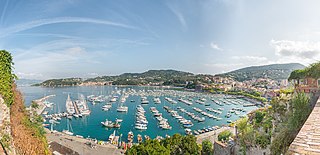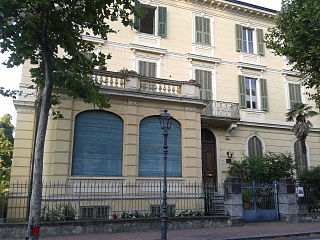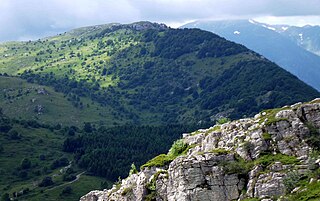
The Italian Riviera or Ligurian Riviera is the narrow coastal strip in Italy which lies between the Ligurian Sea and the mountain chain formed by the Maritime Alps and the Apennines. Longitudinally it extends from the border with France and the French Riviera near Ventimiglia eastwards to Capo Corvo which marks the eastern end of the Gulf of La Spezia and is close to the regional border between Liguria and Tuscany. The Italian Riviera thus includes nearly all of the coastline of Liguria. Historically the "Riviera" extended further to the west, through what is now French territory as far as Marseille.

Liguria is a region of north-western Italy; its capital is Genoa. Its territory is crossed by the Alps and the Apennines mountain range and is roughly coextensive with the former territory of the Republic of Genoa. Liguria is bordered by France to the west, Piedmont to the north, and Emilia-Romagna and Tuscany to the east. It rests on the Ligurian Sea, and has a population of 1,557,533. The region is part of the Alps–Mediterranean Euroregion.

The Ligures or Ligurians were an ancient people after whom Liguria, a region of present-day north-western Italy, is named. Because of the strong Celtic influences on their language and culture, they were also known in antiquity as Celto-Ligurians.

Arturo Issel was an Italian geologist, palaeontologist, malacologist and archaeologist, born in Genoa. He is noted for first defining the Tyrrhenian Stage in 1914. Issel was also renowned at the time for his work on codifying information within anthropology and ethnology, for which he is still remembered.

The Genova-Ventimiglia railway runs along the coast of the Liguria region of Italy. It was opened as a single track line between Genova and Savona in 1868, and between Savona and Ventimiglia in 1872, mostly running along a coastal corniche.

The Delle Piane family is an old Genoese noble family first recorded in Polcevera in 1121. Over the past ten centuries it has produced many distinguished government officials, clerics, diplomats, soldiers and patrons.

Bric delle Camere is a mountain in northern Italy, part of the Ligurian Apennines. It is located in the provinces of Genoa and Alessandria. It lies at an altitude of 1016 metres.
The following is a timeline of the history of the city of Genoa, Liguria, Italy.

Luigi Bernabò Brea was an Italian archaeologist.

The Istituto Internazionale di Studi Liguri is an educational institution in Bordighera, Imperia, devoted to the study of the history of Liguria and all the coastal regions of the Mediterranean that were originally populated by the Ligurians. The building is located at Via Romana 39 and once housed the Hotel Scandinavia.

Monte Armetta is a mountain in Piedmont, northern Italy, part of the Alps. At an altitude of 1,739 metres it is the highest summit of the Ligurian Prealps.

Flegomene was the pen name of an 18th-century Italian physicist.
Luca Assarino was an Italian writer, journalist and informer. His novel La Stratonica was among the most read novels in the 17th-century Italy.

Monte Cianea is a 1,226-metre (4,022 ft) mountain of the Ligurian Prealps, in Italy.
Marcello Baschenis was an Italian painter.

Monte Peso Grande o Castell'Ermo (1.092 m) is a mountain of the Ligurian Prealps, the eastern section of the Ligurian Alps.

The Monte Camulera is a mountain of the Ligurian Prealps, the eastern section of the Ligurian Alps.
The Ligurian Prealps are a mountain range in northwestern Italy. They belong to the Ligurian Alps and are located between the regions of Piemonte and Liguria. Their highest summit is the monte Armetta, at an elevation of 1,739 metres (5,705 ft).
Fiorenzo Toso was an Italian academic, linguist, and dialectologist.
Benvenuto Francesco Pesce Maineri was an Italian architect, engineer, and urban planner, known for his contributions to the Art Nouveau and Eclecticism styles in Italy during the late 19th and early 20th centuries.
















